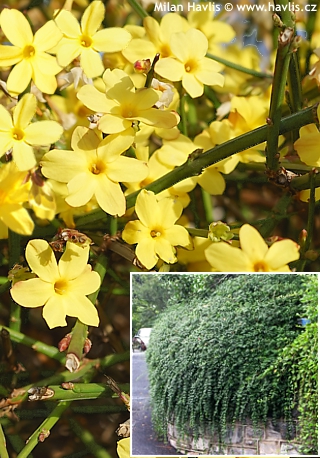Jasminum nudiflorum

Jasminum nudiflorum
winter jasmine
winter jasmine
| SIZE/TYPE | medium-sized shrub |
|---|---|
| low or groundcovering | |
| USUAL HEIGHT | 1-2m |
| USUAL WIDTH | 1-3m |
| LEAVES | deciduous broadleaf |
| COLOUR OF LEAVES |
 green green |
| FLOWERS | showy |
| COLOUR OF FLOWERS |
 yellow yellow
|
| BLOOMING TIME | January - March |
| LOCATION | full sun |
| SOIL TYPE | any (acidic to alkaline) |
| SOIL MOISTURE REQUIREMENTS | evenly moist but well-drained |
| USDA zone (lowest) | 5 (down to -29°C) |
| WINTER PROTECTION | |
| FOR ZONE 5+6 |

|
| FOR ZONE 7 |

|
| BELONGS TO CATEGORIES |
Deciduous broadleaf Winter blooms |
Winter jasmine is a deciduous shrub native to western China and Tibet where it was discovered by a significant Scottish botanist and plantsman Robert Fortune (1812-1880) during his long-term stay in China between 1843 and 1861. He collected its seeds and sent them to England to his friend, also a botanist John Lindley (1799-1865), who planted them and described the plant for the first time. The shrub was propagated and in Britain, where winter frosts are marginal, it bloomed from November to February which made it a top popular winter plant there.
Winter jasmine belongs to a large genus of more than 200 very different species occurring in Europe, Asia, and Africa. This is probably the only type of true jasmine that can be cultivated in our country (zone 5-6), we just have to show some leniency when it comes to a typical jasmine feature – the fragrance – because it lacks any scent whatsoever. But the beauty as well as the quantity of flowers will definitely make up for it.
From the first warm days of late winter appears a profusion of deep, scarlet red buds which burst to vivid yellow, 6-petalled flowers borne on bare wood, hence its Latin name nudiflorum. They keep popping up continuously for 4-8 weeks. The deciduous leaves resemble those of cinquefoil, they are trifoliate, narrowly oval, and shiny green. The twigs are square-shaped and green all year round, so even without leaves the plant looks fresh and not dormant.
It is a fast and low-growing deciduous shrub, often erroneously listed as a climber, because its long twigs are often tied to a vertical support, so that it soon covers walls and fences. On the other hand, its vigorous growth makes it quite a challenge if you want to keep the plant nice which is simple to achieve by regular and easy pruning. Immediately after flowering, cut the twigs back by 50-80% of length, and once in 5-7 years cut the plant almost to the ground for rejuvenation. Keep in mind that it can grow up to one meter per year, and adult, well-established plants even more. In return, it offers a handsome, well-branched cascades of new, strong, arching twigs with evenly distributed foliage and abundant flowering in winter. Without support, it grows mostly as a groundcover and takes a long time to exceed one meter in height thanks to randomly upright twigs.
Winter jasmine is so easy to grow – it prefers alkaline, well-drained soil, but it can cope with almost any but waterlogged soil. All it needs is a location in full sun. It does not require feeding and does not suffer from diseases or pests. Very hardy to min. -27 °C (USDA zone 5b), and in protected places it can handle a few degrees lower.
Last update: 06-03-2022
SIZES and PRICES
CURRENTLY SOLD OUT
GLOSSARY
|











